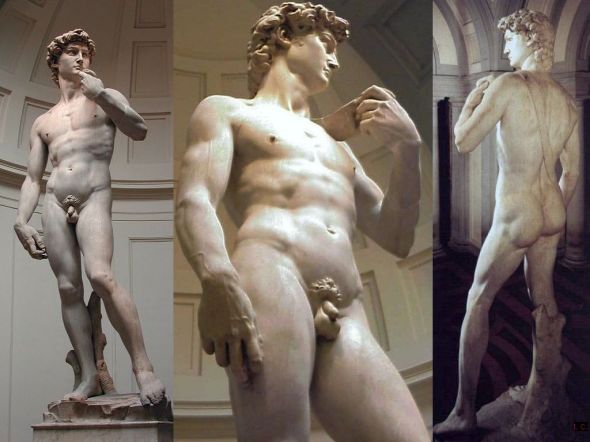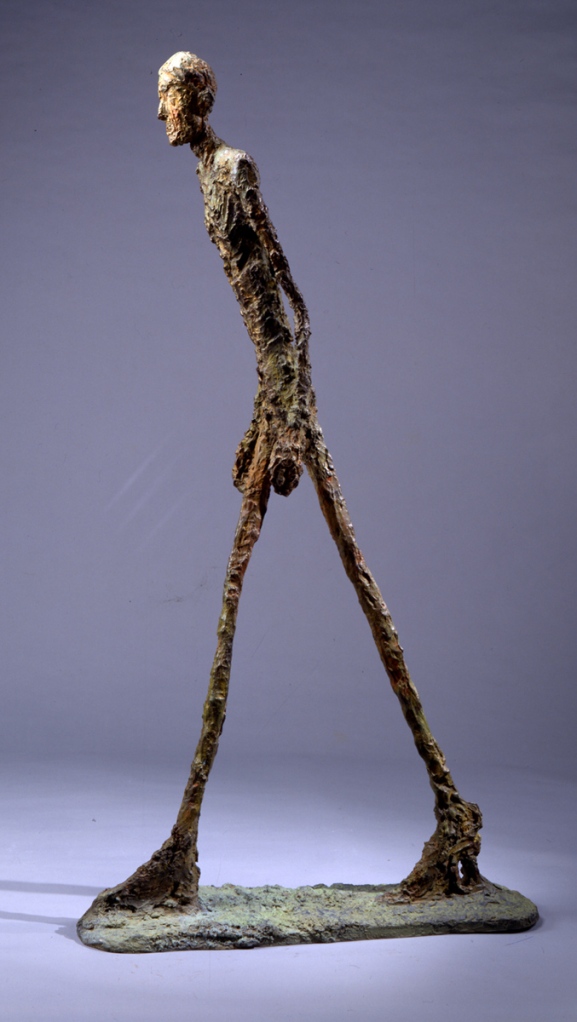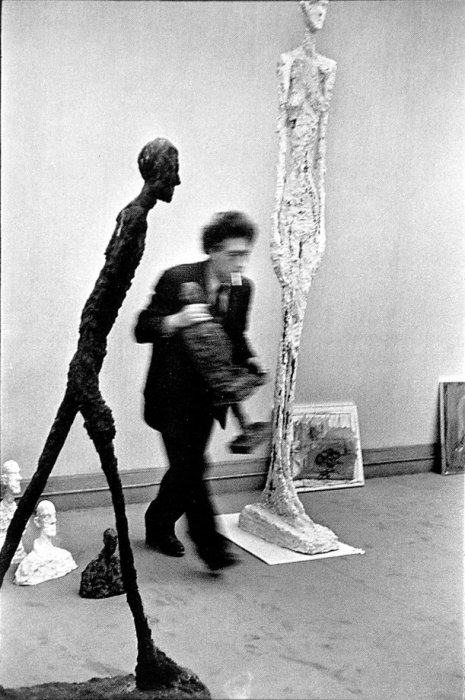GIACOMETTI, Existentialism & General Sculptural Discomfort
Normally when we think of sculpture, we think of artists’ attempts to replicate the beauty and complexity of the human body. We think of pieces like Michelangelo’s David: truly a masterpiece and a representation of the ideal male form. We see David’s identifiable musculature, his flawless skin, and his identifiable strong, Italian facial features. His body stands confident and stoic, a slingshot slung over his shoulder, his gaze outward, his stance ready for the next step in the story: Goliath’s approach. He shines as an example of Florentine strength at the turn of the 16th century.
If you learn nothing else from my blogs, you should learn that art is a representation of its time period (whether the artist likes it or not). This type of muscular sculpture was well-suited to its time period.
When we look at more modern sculpture, we are sometimes jarred, intrigued and often uncomfortable. Alberto Giacometti’s signature style, represented best in his Walking Man I, depicts a very different style of sculpture. Standing larger than life size, at over 6 feet tall, this sculpture seems to tower over us. What exactly are we looking at? An incredibly simple pose that we encounter every day; one that we most likely fail to recognize: a man walking. But what is different about this man? Why doesn’t he look like a Michelangelo, what makes him different and how does this make us feel? These are all important questions that the artist wanted us to consider when looking at this haunting sculpture.
In my experience interning and giving tours at the Art Institute of Chicago, when I would bring audiences to this sculpture, one of two things would happen depending on the age group. When asked to list adjectives that they associate with this piece, anyone above the average age of 25 would say: haunting, starvation, Holocaust, concentration camps. Anyone below the age of 25 (especially teenagers) would say: skinny, thin, anorexic, eating disorder. That right there shows a major distinction in cultural value systems between people of different ages, even in the same country.
In fact, the artist most likely was referencing both the Holocaust and Existentialism (both quite perky topics). He began creating these elongated, thin figures slightly before the onset of WWII, but made them only about as big as a pack of cigarettes. He lived in France during the German Occupation, and eventually moved back to Switzerland when restrictions became too tight. He only began creating his larger, more well-known pieces after the end of the war. He began creating this series of Walking Men in the late 1950s.
So, who’s excited to talk about existentialism!?! Existentialism was a French philosophical movement that began in the years after the second world war. While it was primarily experienced by a ravaged Europe, bits of it did trickle into America, mostly through college education. After the G.I. Bill came into effect after the end of WWII, the government paid tuition in full for many who fought in the war. The main tenets of existentialism, while much more complicated than I will make it seem in the next few sentences, respond to the isolation and desolation so poignantly felt by those who suffered in WWII. Existentialism holds that there is no grand meaning in life; there is no rhyme or reason to why things happen. The world as a whole is absurd and irrational, and does not contain any inherent moral value system. However, this does not mean that values don’t exist! It simply means that we are responsible for our own experience in this world, moral values included.
While to some this may sound fairly liberating (“I have complete control over my life and my experience in this world!”), many found the idea of the lack of a grand meaning in life to be quite isolating. (“So, we’re all on this journey by ourselves and there’s no real reason for it?”)
Giacometti’s sculptures reflect this feeling of isolation. Much of the reason why we feel discomfort looking at them is that, unlike Michelangelo’s David, Giacometti’s sculptures are completely out of touch with our sensory experience of the body. While we can identify limbs, we can’t identify any form of musculature, nor skin covering the musculature. The closest thing we come to identifying is a skeletal bone structure, which, without musculature and skin, reminds us of something sick or dying. Even a common subject, such as a man walking, becomes utterly foreign to us. This feeling of the foreign, the isolated, the loneliness, parallels the feelings of many people who were reacting to WWII and Existentialism. So, you see, there is a big reason why not all sculpture looks like Michelangelo’s work! While it may be harder for us to look at, there is usually a reason why we feel this way. And often, that’s the point.
If you learn nothing else from my blogs, you should learn that art is a representation of its time period (whether the artist likes it or not). This type of muscular sculpture was well-suited to its time period.
When we look at more modern sculpture, we are sometimes jarred, intrigued and often uncomfortable. Alberto Giacometti’s signature style, represented best in his Walking Man I, depicts a very different style of sculpture. Standing larger than life size, at over 6 feet tall, this sculpture seems to tower over us. What exactly are we looking at? An incredibly simple pose that we encounter every day; one that we most likely fail to recognize: a man walking. But what is different about this man? Why doesn’t he look like a Michelangelo, what makes him different and how does this make us feel? These are all important questions that the artist wanted us to consider when looking at this haunting sculpture.
In my experience interning and giving tours at the Art Institute of Chicago, when I would bring audiences to this sculpture, one of two things would happen depending on the age group. When asked to list adjectives that they associate with this piece, anyone above the average age of 25 would say: haunting, starvation, Holocaust, concentration camps. Anyone below the age of 25 (especially teenagers) would say: skinny, thin, anorexic, eating disorder. That right there shows a major distinction in cultural value systems between people of different ages, even in the same country.
In fact, the artist most likely was referencing both the Holocaust and Existentialism (both quite perky topics). He began creating these elongated, thin figures slightly before the onset of WWII, but made them only about as big as a pack of cigarettes. He lived in France during the German Occupation, and eventually moved back to Switzerland when restrictions became too tight. He only began creating his larger, more well-known pieces after the end of the war. He began creating this series of Walking Men in the late 1950s.
So, who’s excited to talk about existentialism!?! Existentialism was a French philosophical movement that began in the years after the second world war. While it was primarily experienced by a ravaged Europe, bits of it did trickle into America, mostly through college education. After the G.I. Bill came into effect after the end of WWII, the government paid tuition in full for many who fought in the war. The main tenets of existentialism, while much more complicated than I will make it seem in the next few sentences, respond to the isolation and desolation so poignantly felt by those who suffered in WWII. Existentialism holds that there is no grand meaning in life; there is no rhyme or reason to why things happen. The world as a whole is absurd and irrational, and does not contain any inherent moral value system. However, this does not mean that values don’t exist! It simply means that we are responsible for our own experience in this world, moral values included.
While to some this may sound fairly liberating (“I have complete control over my life and my experience in this world!”), many found the idea of the lack of a grand meaning in life to be quite isolating. (“So, we’re all on this journey by ourselves and there’s no real reason for it?”)
Giacometti’s sculptures reflect this feeling of isolation. Much of the reason why we feel discomfort looking at them is that, unlike Michelangelo’s David, Giacometti’s sculptures are completely out of touch with our sensory experience of the body. While we can identify limbs, we can’t identify any form of musculature, nor skin covering the musculature. The closest thing we come to identifying is a skeletal bone structure, which, without musculature and skin, reminds us of something sick or dying. Even a common subject, such as a man walking, becomes utterly foreign to us. This feeling of the foreign, the isolated, the loneliness, parallels the feelings of many people who were reacting to WWII and Existentialism. So, you see, there is a big reason why not all sculpture looks like Michelangelo’s work! While it may be harder for us to look at, there is usually a reason why we feel this way. And often, that’s the point.



No comments:
Post a Comment